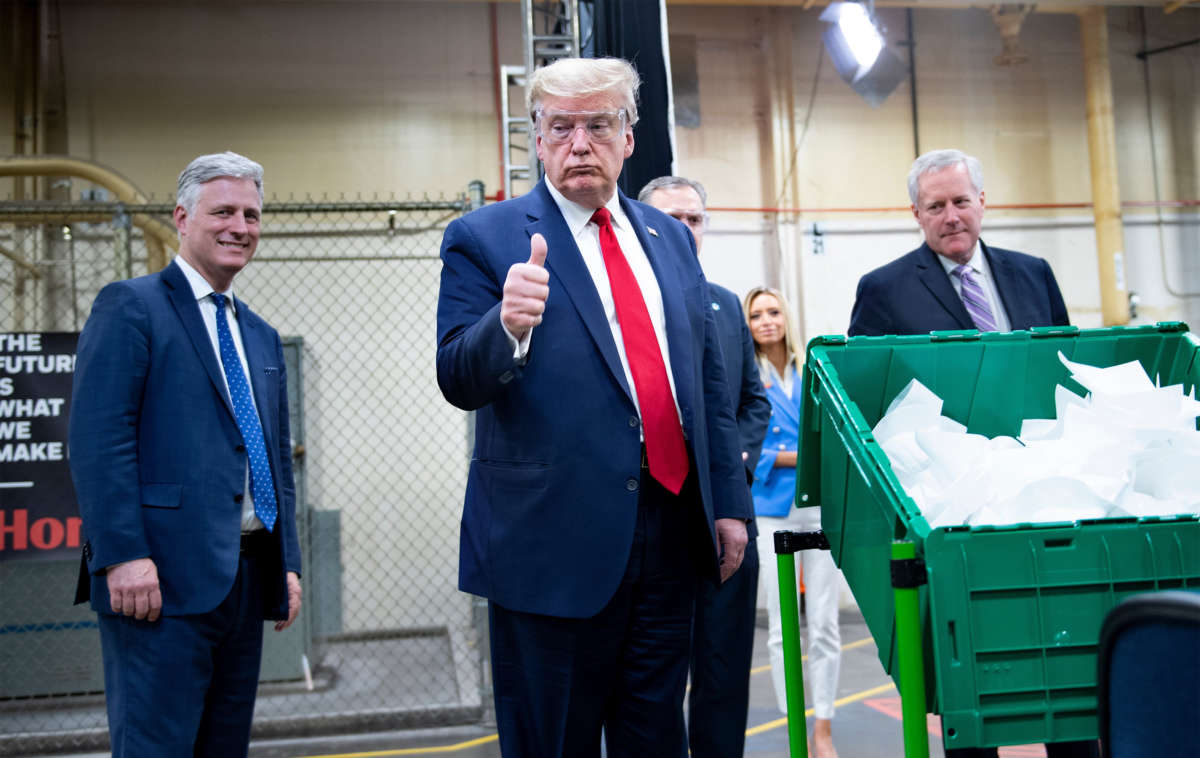Did you know that Truthout is a nonprofit and independently funded by readers like you? If you value what we do, please support our work with a donation.
President Donald Trump announced on Twitter Wednesday that the coronavirus task force would not be disbanding, as had been previously reported, but will transition to focus on the task of “opening up” the United States’ economy, shifting away from its present task of mitigating and preventing the spread of COVID-19 across the country.
Commending Vice President Mike Pence and the task force for what he called a “fantastic job,” Trump cited the high number of ventilators, gloves, gowns and other personal protective equipment that was produced.
“Because of this success, the Task Force will continue on indefinitely with its focus on SAFETY & OPENING UP OUR COUNTRY AGAIN,” Trump wrote. “We may add or subtract people to it, as appropriate.”
….produced in the thousands, and we have many to spare. We are helping other countries which are desperate for them. Likewise, after having been left little, we are now doing more testing than all other countries combined, and with superior tests. Face masks & shields,….
— Donald J. Trump (@realDonaldTrump) May 6, 2020
….to it, as appropriate. The Task Force will also be very focused on Vaccines & Therapeutics. Thank you!
— Donald J. Trump (@realDonaldTrump) May 6, 2020
The president also stated that the task force would remain dedicated to finding a vaccine and looking at therapeutics for treating coronavirus.
Trump and other administration officials had previously suggested that the task force might be disbanded completely by the end of the month, with most of their tasks reverting to federal agencies after doing so.
While Trump celebrated the increased availability of PPE and ventilators, a number of nurses, doctors, and other healthcare professionals have stated they are still undersupplied with the protective gear, with some describing such strict rules in place requiring them to use just one mask per day, when in normal practice masks should be regularly discarded from patient-to-patient.
These worries are being echoed behind closed doors by members of the Federal Emergency Management Agency and the Department of Health and Human Services, who have privately expressed among themselves that ending stay-at-home measures in order to achieve the president’s goal of “reopening” the economy would likely produce shortages across the country.
Audio obtained by Politico highlighted federal officials’ deep concerns. “The numbers of deaths definitely will be high,” Daniel Jernigan, the director of the influenza division at the Centers for Disease Control and Prevention, acknowledged in one recording.
Another official described how ending stay-at-home measures would result in a ventilator shortage.
“If, at the end of stay-at-home orders, you were to lift everything and go back to normal business, and not have any community mitigation, you would expect to see in the second week in May we begin to increase again in ventilator uses,” that official said. “Which means cases increase, and by early June, we surpass the number of ventilators we currently have.”
Scientific models presented to these officials within their meetings, which took place between April 24 and May 1, confirmed that, in a worst-case-scenario situation where no mitigation occurred after ending stay-at-home orders across the country, there would indeed be a ventilator shortage.
Other models are also predicting a more dire outcome due to the end of social distancing rules in a number of U.S. states. The University of Washington’s Institute for Health Metrics and Evaluation (IHME) revised its projection of how many deaths would occur across the country to 134,475 by August — a drastic upward change of more than 60,000 from its previous estimate.
The change came about, IHME explained, in part due to states easing social distancing and other areas not adhering strongly enough to their rules.
Press freedom is under attack
As Trump cracks down on political speech, independent media is increasingly necessary.
Truthout produces reporting you won’t see in the mainstream: journalism from the frontlines of global conflict, interviews with grassroots movement leaders, high-quality legal analysis and more.
Our work is possible thanks to reader support. Help Truthout catalyze change and social justice — make a tax-deductible monthly or one-time donation today.
